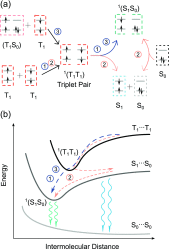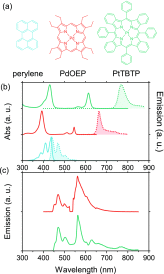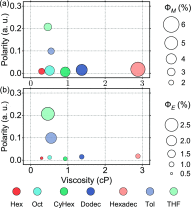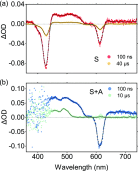Annihilation Versus Excimer Formation by the Triplet Pair in Triplet-Triplet Annihilation Photon Upconversion
- PMID: 31131601
- PMCID: PMC6608582
- DOI: 10.1021/jacs.9b02302
Annihilation Versus Excimer Formation by the Triplet Pair in Triplet-Triplet Annihilation Photon Upconversion
Abstract
The triplet pair is the key functional unit in triplet-triplet annihilation photon upconversion. The same molecular properties that stabilize the triplet pair also allow dimers to form on the singlet energy surface, creating an unwanted energy relaxation pathway. Here we show that excimer formation most likely is a consequence of a triplet dimer formed before the annihilation event. Polarity-dependent studies were performed to elucidate how to promote wanted emission pathways over excimer formation. Furthermore, we show that the yield of triplet-triplet annihilation is increased in higher-viscosity solvents. The results will bring new insights in how to increase the upconversion efficiency and how to avoid energy-loss channels.
Conflict of interest statement
The authors declare no competing financial interest.
Figures






Similar articles
-
Optimizing photon upconversion by decoupling excimer formation and triplet triplet annihilation.Phys Chem Chem Phys. 2020 Jan 21;22(3):1715-1720. doi: 10.1039/c9cp06561j. Epub 2020 Jan 2. Phys Chem Chem Phys. 2020. PMID: 31895392
-
Solvent effects on the triplet-triplet annihilation upconversion of diiodo-Bodipy and perylene.Phys Chem Chem Phys. 2017 Jan 4;19(2):1516-1525. doi: 10.1039/c6cp06897a. Phys Chem Chem Phys. 2017. PMID: 27990551
-
Diphenylanthracene Dimers for Triplet-Triplet Annihilation Photon Upconversion: Mechanistic Insights for Intramolecular Pathways and the Importance of Molecular Geometry.J Am Chem Soc. 2021 Apr 21;143(15):5745-5754. doi: 10.1021/jacs.1c00331. Epub 2021 Apr 9. J Am Chem Soc. 2021. PMID: 33835789 Free PMC article.
-
Photochemical Upconversion.Annu Rev Phys Chem. 2023 Apr 24;74:145-168. doi: 10.1146/annurev-physchem-092722-104952. Epub 2023 Jan 25. Annu Rev Phys Chem. 2023. PMID: 36696592 Review.
-
Triplet-Triplet Annihilation Upconversion-Based Photolysis: Applications in Photopharmacology.Adv Healthc Mater. 2024 Jul;13(19):e2400354. doi: 10.1002/adhm.202400354. Epub 2024 Apr 21. Adv Healthc Mater. 2024. PMID: 38613491 Review.
Cited by
-
Blue-to-UVB Upconversion, Solvent Sensitization and Challenging Bond Activation Enabled by a Benzene-Based Annihilator.Angew Chem Int Ed Engl. 2023 Feb 13;62(8):e202215340. doi: 10.1002/anie.202215340. Epub 2023 Jan 16. Angew Chem Int Ed Engl. 2023. PMID: 36398891 Free PMC article.
-
The statistical probability factor in triplet mediated photon upconversion: a case study with perylene.J Mater Chem C Mater. 2023 Oct 2;11(42):14826-14832. doi: 10.1039/d3tc03158f. eCollection 2023 Nov 2. J Mater Chem C Mater. 2023. PMID: 38013844 Free PMC article.
-
Promoting multiexciton interactions in singlet fission and triplet fusion upconversion dendrimers.Nat Commun. 2023 Sep 28;14(1):6080. doi: 10.1038/s41467-023-41818-1. Nat Commun. 2023. PMID: 37770472 Free PMC article.
-
Modulating TTA efficiency through control of high energy triplet states.J Mater Chem C Mater. 2022 Feb 22;10(12):4923-4928. doi: 10.1039/d1tc05292f. eCollection 2022 Mar 24. J Mater Chem C Mater. 2022. PMID: 35433005 Free PMC article.
-
Ultra-small PbS nanocrystals as sensitizers for red-to-blue triplet-fusion upconversion.Chem Sci. 2021 Oct 11;12(42):14111-14120. doi: 10.1039/d1sc04330g. eCollection 2021 Nov 3. Chem Sci. 2021. PMID: 34760195 Free PMC article.
References
-
- Singh-Rachford T. N.; Castellano F. N. Photon upconversion based on sensitized triplet-triplet annihilation. Coord. Chem. Rev. 2010, 254, 2560–2573. 10.1016/j.ccr.2010.01.003. - DOI
-
- Pedrini J.; Monguzzi A. Recent advances in the application triplet-triplet annihilation-based photon upconversion systems to solar technologies. J. Photonics Energy 2018, 8, 022005.10.1117/1.JPE.8.022005. - DOI
-
- Frazer L.; Gallaher J. K.; Schmidt T. W. Optimizing the Efficiency of Solar Photon Upconversion. ACS Energy Lett. 2017, 2, 1346–1354. 10.1021/acsenergylett.7b00237. - DOI
Publication types
LinkOut - more resources
Full Text Sources

